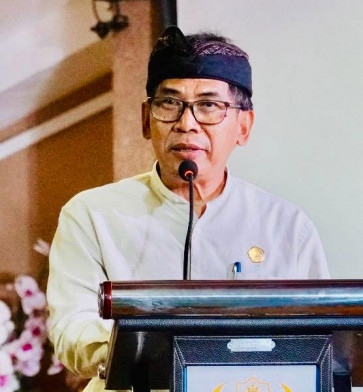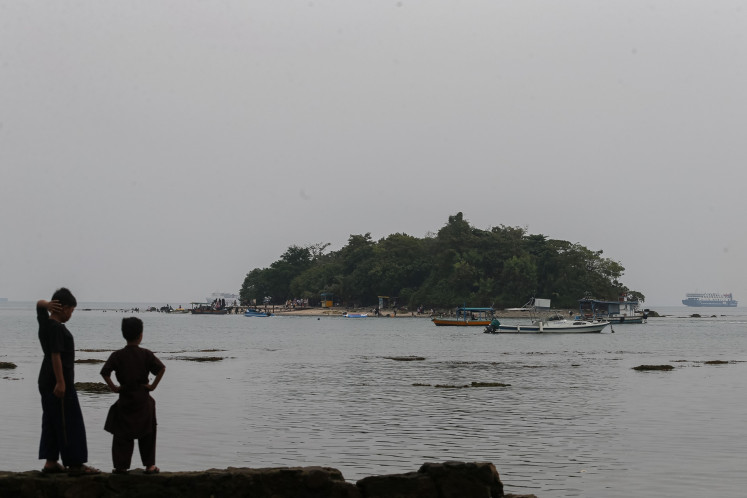Popular Reads
Top Results
Can't find what you're looking for?
View all search resultsPopular Reads
Top Results
Can't find what you're looking for?
View all search resultsRemembering maestro Nyoman Lempad during Panca Wali Krama
Maestro: Aside from painting and sculpting, I Gusti Nyoman Lempad was also known for his designs of traditional Balinese buildings and talent for crafting ritual objects
Change text size
Gift Premium Articles
to Anyone

M
aestro: Aside from painting and sculpting, I Gusti Nyoman Lempad was also known for his designs of traditional Balinese buildings and talent for crafting ritual objects.
As Bali celebrates the once a decade event of Panca Wali Krama, the island’s art community is reminded of I Gusti Nyoman Lempad, a celebrated artist who died during the Balinese Hindu ritual period in 1978.
I Gusti Nyoman Lempad was a one of a kind Balinese artistic maestro. Born in 1847, the renowned painter and sculptor was also known for his designs of traditional Balinese buildings and talent for crafting ritual objects, such as barong and ngaben towers.
Lempad was also a major supporter of Pita Maha (Big Creativity), an art organization founded by Walter Spies, Rudolf Bonnet and Tjokorda Gde Agung Sukawati in 1936.
Given his amazing achievements, it is surprising that only a small group of people knew when Lempad passed away at the age of 131 in Ubud, Bali, on April 25, 1978.
“It was strange but true. I got the news about Lempad’s passing only in the middle of May,” recalled Anak Agung Made Djelantik, a doctor and cultural expert who was good friends with Lempad.
When Lempad was pronounced dead, the Ubud community was calm, there was no knocking of bamboo to signal his death and no one paid any condolence calls. This was because when Lempad breathed his last breath, Panca Wali Krama was underway in Bali, so Lempad’s death was kept secret.
Panca Wali Krama, held once every ten years based on the Balinese calendar, is the island’s second largest ritual after Eka Dasa Rudra, which is held once every 100 years.
Balinese Hindus are currently observing Panca Wali Krama, which runs from Jan. 20 until April 4. One of the rituals, Karya Agung Panca Wali Krama on March 6, is a grand ceremony at the Pura Agung Besakih Temple in Karangasem aimed at achieving harmony in nature and society.

Panca Wali Krama is the only time Hindu adherents on the island “are forbidden to die”, as written in the Bhama Kerthi manuscript.
People are prohibited from conducting purification activities connected with death, including the cremation ceremony of ngaben.
The rules say that if the person who dies during this time is an ordinary resident of a lower caste, a burial can be carried out “silently” at night by using small torches as the only source of light. The night funeral is aimed at preventing any sadness from tarnishing Panca Wali Krama. The family is also not allowed to announce the death.
If the deceased has a high position in society, such as being a sulinggih or pemangku (priest), a funeral is forbidden, let alone a ngaben ceremony.
The body is to be laid out in the home and preserved with herbs. The only ritual permitted is the spraying of tirtha pemarisudha, sacred water from Pura Besakih, by family members.
“In the whole world, only Panca Wali Krama of Bali’s Hindus can defer somebody’s death,” said Garrett Kam, a Hawaii-based researcher and author.
Lempad’s death during Panca Wali Karma has long been a subject of discussion among those interested in the cultural history of Bali.
“Every time Karya Agung Panca Wali Krama is in progress, I always remember Lempad,” said Suteja Neka, the founder of Museum Neka in Ubud, which has a pavilion dedicated to Lempad’s work.

The official date of Lempad’s death is May 9, 1978, several weeks after he passed away.
His body was given a pelebon (grand ngaben) ceremony in Ubud, which was widely covered by international media.
Tens of thousands of Balinese people and artists from around the world attended the funeral. Among them was French and Spanish fashion designer Paloma Picasso, the daughter of 20th century painter Pablo Picasso.
“Maestro Lempad’s funeral ceremony is much grander than that for my father,” Paloma said at the time.
Australian filmmakers John Darling and Lorne Blair recorded the significant event for their acclaimed documentary, Lempad of Bali.
During his life, Lempad received numerous accolades for his artistic achievements. Among them are Anugerah Seni from the Indonesian government in 1970 and Dharma Kusuma from the Bali administration in 1982.
His works are displayed in numerous museums around the globe, including Tropenmuseum in Amsterdam and the National Museum of Ethnology in Leiden, the Netherlands.
The maestro is remembered through the Lempad Prize, an art award granted by the Sanggar Dewata studio to Indonesian visual artists with outstanding achievements.
After his death, his house in Ubud was turned into a museum, but sadly the property is poorly managed, prompting calls for the government to support the museum.

— Photos by Agus Dermawan T.









